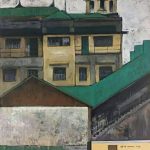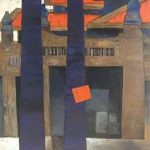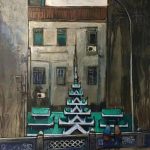The Irrawaddy Magazine |
- Army, Govt Warn of Militant Attacks on Cities
- New Inventory Reveals Nearly 4,000 Ancient Monuments in Bagan
- Myanmar’s First Gold Exchange Center Takes Shape in Yangon
- Dozens of Hindus Killed in Maungdaw: Relatives
- Win Tint Craves New Ideas, Even After Success
- Wathann Film Festival Features Local Talent
- Ten Things to Do in Yangon This Week
- Casinos in Myawaddy
| Army, Govt Warn of Militant Attacks on Cities Posted: 05 Sep 2017 08:46 AM PDT The Myanmar Army released a statement on Tuesday afternoon alleging that the Arakan Rohingya Salvation Army (ARSA) could plan to stage attacks in Myanmar's major cities. The public alert, put forward by the Office of the Commander-in-Chief, did not provide evidence for the claim. The Government Information Committee issued its own statement on Tuesday night reiterating the military's earlier warning, and calling for people to act with restraint. "People should be strongly mindful that some could instigate racial and religious violence by using the alert as a pretext," it read, adding that the administration "strongly urges the people to collaborate for the country's stability." The army listed Naypyitaw, Yangon, Mandalay and Mawlamyine as potential targets, and speculated that the ARSA has foreign ties and alleged that members had received training abroad as migrants. ARSA's activity has been in northern Rakhine State, where the group staged attacks on police and military targets on Aug. 25, leading to the government and military designating the organization as "terrorists." The Myanmar Army has since intensified clearance operations in the region. Four hundred people have been reported dead, and an estimated 125,000 have fled to Bangladesh. Tens of thousands more remain displaced internally. In Tuesday's statement, the army asked the public to inform police or military officials of "suspicious activity," like the presence of large amounts of ammonium nitrate fertilizer. During a briefing last week for diplomats and UN agencies on Rakhine State at the National Reconciliation and Peace Center in Yangon, Police Brig-Gen Win Tun alleged that militants had used this type of fertilizer to make landmines. The post Army, Govt Warn of Militant Attacks on Cities appeared first on The Irrawaddy. |
| New Inventory Reveals Nearly 4,000 Ancient Monuments in Bagan Posted: 05 Sep 2017 08:01 AM PDT YANGON — The Association of Myanmar Architects (AMA) logged 3,822 monuments in the ancient capital of Bagan in the first inventory of its kind for more than 20 years, it revealed on Tuesday. Data collection for the Bagan Architecture Inventory was done from mid October to late December last year, with the help of some 300 volunteer architects and students, according to the association. From the inventory's 3,822 monuments, AMA identified 3,699 within Bagan's archaeological zone. The remaining 123 structures were recorded by the Department of Archaeology outside of the zone before the inventory process. The inventory used the previous two records of religious monuments in Bagan–one Unesco-supported effort by French architect Pierre Pichard in the 1980s and another by the Myanmar Archaeological Department in 1996. Pichard's Inventory of Monuments at Pagan" stated that the ancient capital had 2,834 ancient monuments and the archaeology department in its inventory stated Bagan had 3,122. Aug. 24 marked one year since the powerful 6.8-magnitude earthquake struck central Myanmar, centered about 15 miles west of Chauk town in Magwe Region. According to the religion and culture ministry's archaeology department, out of more than 3,000 temples and pagodas across Bagan—located north of the epicenter—389 were affected by tremors and needed renovation. The inventory was planned before the quake, but with the damage sustained by temples, work on the inventory was quickened to record the ancient architecture before it underwent repairs. "The inventory is [important] not only for the architects' association but also for all Myanmar people who value Bagan," AMA's vice-chair U Maw Lin told media on Tuesday in Yangon. "It is of concern to all Myanmar people and they deserve to know [the findings] as well," he added. The ancient capital has yet to be granted Unesco World Heritage Site status, allegedly on account of sub-standard, inauthentic restoration efforts under previous governments. AMA chair U Sun Oo said one Unesco worker recognized Bagan as having the most mural paintings in Southeast Asia. According to the association's inventory, 392 structures—14 percent of Bagan's ancient monuments—still have mural paintings. The association aimed at completing the inventory before Myanmar's bid in September this year for Bagan to make the Unesco World Heritage Site list. The inventory would also serve as a reference for future restoration works, U Sun Oo added. "If these monuments have to be renovated, we are concerned the work will not be carried out systemically without such an inventory," said U Sun Oo. "Even if the renovation works are done recklessly we will at least have a record of how these structures appeared in the past." According to AMA's findings, 1,179 monuments—32 percent of Bagan's ancient structures identified by the association—are totally deserted, 1,633 are ignored and only 848 are structures that have frequent public access. Only 327 monuments—9 percent—are preserved and restored, AMA's inventory claimed. The post New Inventory Reveals Nearly 4,000 Ancient Monuments in Bagan appeared first on The Irrawaddy. |
| Myanmar’s First Gold Exchange Center Takes Shape in Yangon Posted: 05 Sep 2017 05:48 AM PDT YANGON — Myanmar will have its first official market for gold, gems and metal trading in its commercial capital Yangon this year, said U Khin Maung Han, chairman of the Myanmar Federation of Mining Association. The trade center will be built in Yangon's Mingalardon Township near Yangon International Airport, U Khin Maung Han said. The association is in the process of discussing land acquisition and security matters with the concerned ministries, he said. "We will build a temporary center near 6th Mile [in Mayangon Township] while the trade center is being built in Mingalardon. We are establishing an official market for the trading of gold, jewelry and gold items and metal," he told The Irrawaddy. Similar centers will also be built in Naypyitaw and Mandalay, and are expected to be completed in two years. The official market will prevent the smuggling of gold and jewelry items and metal, and will assist the government in identifying the precise number of deals, as well as earn tax revenues, U Khin Maung Han explained. "The official market will also encourage gem factories and create job opportunities," he said. The official gold market has been in the works for three years, and various ministries and agencies, including the Ministry of Planning and Finance, Ministry of Natural Resources and Environmental Conservation, Ministry of Commerce, Central Bank of Myanmar, Myanmar Federation of Mining Association and Myanmar Gold Entrepreneurs have been collaborating in its creation. "We've coordinated with concerned businessmen to open a gold and gems trading center round the clock throughout the year," said Union minister for Planning and Finance U Kyaw Win at the ninth meeting between Vice President Henry Van Thio and local businessmen. "Dealings will be made there, taxes will be levied there. They can either export or sell to local buyers. And related handicraft businesses and other services can be provided there on a wide scale. Only then, will we have a Myanmar market, and our products will fetch good prices," the minister said. Companies from around 30 countries have expressed their interest in investing in the official gold exchange market, which will be modeled after Shanghai and American gold exchanges. Myanmar has also signed a memorandum of understanding on technical cooperation with Singapore's Gold Market Association. Translated from Burmese by Thet Ko Ko The post Myanmar's First Gold Exchange Center Takes Shape in Yangon appeared first on The Irrawaddy. |
| Dozens of Hindus Killed in Maungdaw: Relatives Posted: 05 Sep 2017 03:02 AM PDT SITTWE, Rakhine State – Eight-year-old Muni is one of the sole survivors in her Hindu family, after eight of her relatives were reportedly killed by Muslim militants one week ago in Kha Mauk Seik village, some 40 miles from downtown Maungdaw, in northern Rakhine State. The girl had left her family to work in the home of a friend, Mina Kumari, also in Maungdaw Township, six months earlier. Through an interpreter, Muni told The Irrawaddy on Sunday a statement that was echoed by other relatives and a Hindu community leader in Bangladesh—that she had heard her parents, grandmother, newborn brother, sisters and brothers-in-law had been killed. One of her elder sisters is among eight women who said they were initially abducted by militants from the Arakan Rohingya Salvation Army (ARSA), but now sheltering at a relief camp in Bangladesh's Kutupalong District. Following ARSA attacks on 30 police outposts on Aug. 25, the Myanmar government declared the group a terrorist organization. According to aid workers, Bangladesh is also now hosting some 87,000 self-identifying Rohingya Muslim refugees who have fled northern Rakhine State since the Myanmar Army began renewed clearance operations in Maungdaw following the ARSA attacks. They join hundreds of thousands of Muslim refugees already in the region, displaced after an earlier round of attacks in 2016. An additional 11,700 Buddhist Arakanese, Arakanese subgroups, and Hindus have been internally displaced, with many taking shelter in monasteries in the state capital of Sittwe, and Ponnagyun and Kyauktaw townships. Bangladesh's The Daily Star reported on Sept. 1, that around 400 Hindus had left Rakhine State for Bangladesh and were staying at makeshift camp in Kutupalong, alongside displaced Muslims. More than 500 Hindus are also taking refuge at four temples in Sittwe, partially supported by a government relief team, according to community leaders in Sittwe. The Daily Star said that the displaced villagers estimated that more than 80 members of their communities in Rakhine State had been killed by unidentified armed men. As journalists are barred from the conflict zone, The Irrawaddy spoke to religious leaders and relatives of the deceased in Sittwe. Villagers who arrived in Sittwe on Sunday told The Irrawaddy that they believed around 70 residents of three communities—Kha Mauk Seik Taung Ywar, Kha Mauk Seik Yebaw Kyar, and Ohtein (also known as as Fakirabazar, Riktapara, and Chikonchhari respectively)—had been killed. "The news about Kha Mauk Seik was heard on Saturday, and they are so desperate. They have no family members left to take care for them," said U Maung Hla, the vice chairman of the Rakhine State Hindu Council, referring to 8-year-old Muni and another girl—16-year-old, Kajali, who told The Irrawaddy that since she left Maungdaw four months ago, she had lost nine relatives. Mina Kumari, with whom Muni is living, told The Irrawaddy that she had lost her son in the violence, but had made contact with her daughter-in-law and Muni's sister now in Bangladesh. "My daughter-in-law could not speak properly on the phone, she was crying a lot and was very afraid," said Mina Kumari. Mina Kumari said that her daughter-in-law explained over the phone that she had been forced to undergo a conversion to Islam with seven other women, and that she and her three children avoided being murdered after she gave one of the gunmen her gold earrings. The Irrawaddy was unable to interview the victims directly on the phone, as they said they were too afraid to speak to the media, in either Burmese, Arakanese or Hindi languages. Speaking to The Irrawaddy through an interpreter and on the condition of anonymity, a leader from the Hindu temple in Dakshin Nihla in Bangladesh said that the eight women in question—including Mina Kumari's daughter-in-law—were brought to the temple by Bangladeshi border police. He estimated 470 Hindus had fled to Bangladesh. He alleged that the women were filmed by members of the ARSA and told to say they feared attacks from ethnic Arakanese and the Myanmar security forces. A sister-in-law of one of the survivors of the Hindu villages watched the video and told The Irrawaddy: "I know these women, two are from Buthidaung two are from Maungdaw." It should be noted, however, that widely documented testimony has been given by refugees to international media outlets, human rights organizations, and the UN since Myanmar Army clearance operations from October 2016 to February 2017 following the Oct. 9, 2016 attacks, describing the perpetration of abuses by security forces ranging from torture to rape to arson and extrajudicial killings. Government figures report that since Aug. 25, 15 members of Myanmar's military and police have been killed and 14 civilians—including seven Rakhine Hindus, three Daingnet, and four Arakanese. The government states that 370 suspected militants had been killed since Aug. 25, but these figures do not address the deaths of Muslim civilians, who make up the largest displaced group. The post Dozens of Hindus Killed in Maungdaw: Relatives appeared first on The Irrawaddy. |
| Win Tint Craves New Ideas, Even After Success Posted: 05 Sep 2017 01:02 AM PDT Artist Win Tint came to fame for his paintings of pagodas and temples. His Shwedagon Pagoda series 'Gold and Light' and Bagan series 'Beauty of Monument' were a hit among local art lovers. But his success has not stopped his craving for new ideas. "I always want to present new things rather than old ones. I don't want people to say I show the same old things. I want to give them something new," Win Tint told The Irrawaddy. The magazine illustrator-turned-painter also works as an instructor at Yangon State School of Fine Art, and his exhibitions have been showcased abroad. His latest creations will be showcased at Lokanat Art Gallery from September 2 to 11. The exhibition 'Recent Works' features landscapes of Yangon, Inle Lake and Ava on 3×4 and 4×5-foot canvas. Win Tint said he has used new techniques in his latest works, such as painting with newspaper, which he has enjoyed. "Previously, I only used brushes. But in this exhibition, I use new techniques. I didn't draw waves with a brush, but twisted a newspaper and painted it, and then pushed it [on the canvas]. I love this technique," he said. The exhibition, Win Tint's sixth solo, showcases 11 paintings priced between US$1,500 and $2,000. The post Win Tint Craves New Ideas, Even After Success appeared first on The Irrawaddy. |
| Wathann Film Festival Features Local Talent Posted: 04 Sep 2017 11:44 PM PDT YANGON — Myanmar's pioneering Wathann Film Festival, organized by local independent filmmakers, returns to Yangon's last standing colonial-era Waziya Cinema from Wednesday through Monday for the event's seventh edition. Founded in 2011 with the mission of improving the standard of local cinema and creating a platform for Myanmar's young generation of independent filmmakers, the annual Wathann Film Festival (WFF) will showcase 78 films, including 29 from local directors in the competition section, 23 from other Southeast Asian countries, five international feature-length documentaries and other shorts. Festival director Ma Thu Thu Shein said the WFF has collaborated with curators from regional film festivals to showcase films from six Southeast Asian countries—the S-Express Program—to inspire local filmmakers. "From these Southeast Asian films, they will know what is happening in the regional independent cinema scene," she told The Irrawaddy. Portraying a toddler acting as the "king of the set" on its official poster this year, Ma Thu Thu Shein said it was a metaphor for "new filmmakers are born here," adding that most works in the lineup were created by young directors from Myanmar and the region. Recognizing all of the significant improvements in the last seven years, Thaid Dhi, co-founder and program director of Wathann, said the festival would also address the obstacles that still hinder the artistic freedom of filmmakers, referring to the censorship process that the lineup had to undergo according to the country's 1996 Motion Picture Law. While the decades-long practice of literary censorship was abolished in 2012, he said, the film and video censorship board remains a challenge for local filmmakers. The law urgently needs to be fixed in accordance with democratic norms for the sake of cinematic freedom, he stressed. The festival will also include other artistic programs this year such as Beyond Narrative, a collection of works by audiovisual artists and Another Landscape, a collection of films by the Tokyo Photographic Art Museum. A feature-length documentary In Exile (Pyi Pye in Myanmar), directed by Myanmar filmmaker Tin Win Naing, and a collaboration of Myanmar and Germany production companies, will have its home premiere on Friday evening. The film documents the plight of Myanmar migrant workers who fled civil war and political persecution to Thailand. It has shown at several international film festivals including Busan and Toronto last year. The festival will also screen the Singapore-produced Yellow Bird, a debut feature film by director K. Rajagopal, which was shown at the Cannes Film Festival's Critics Week last year, on Saturday. The film's cinematographer Michael Zaw—a Myanmar-born filmmaker based in Singapore—will host a master class for local filmmakers after the Saturday screening. Myanmar Deitta art gallery will host an extended screening for competition films from Thursday through Sunday. Awards to be presented at the festival are Best Short Film, Best Documentary and New Vision Award, according to festival organizers. The post Wathann Film Festival Features Local Talent appeared first on The Irrawaddy. |
| Ten Things to Do in Yangon This Week Posted: 04 Sep 2017 10:23 PM PDT
AFF U-18 Championship 2017 Myanmar U-18 will play against Indonesia on Tuesday, Brunei on Saturday and the Philippines on Monday. Sept 5, 9, 11, 6 pm. Thuwunna Stadium. Ticket prices 1,000-3,000 kyats
Wathann Film Festival Twenty-nine films are entered in this film festival competition plus more than 70 films from Southeast Asia and Europe will be screened. Sept 6-11, Waziya Cinema.
Shwe Man Chan Tha Thabin Troupe Shwe Man Chan Tha Thabin performs its renowned dance theater to mark its 40th anniversary. Sept 8-9, 6 pm. National Theater, Myoma Kyaung St. Tickets 20,000-50,000 kyats at 09-5011298, 09-421031142, 09-254309453.
Hledan Center 2nd Anniversary Hledan Center will celebrate its second year with entertainment and giveaways. Sept 6. Hledan Center.
Exhibition of Asian Lacquer Works Lacquer art from Myanmar, Japan, Cambodia, Thailand, Vietnam and the US will be showcased. Sept. 9, 1 pm to 5 pm. Myanm/Art. No. 98. 3rd Floor, Bogalay Zay St.
Lat Khat Than Exhibition Lat Khat Than highlights the role of Myanmar textiles as valuable cultural heritage, while exploring innovative business models for developing and sustaining the livelihoods of female weavers in Myanmar's hand-woven textile sector. September 5-10. 9:30 am to 4:30 pm. National Museum.
Girl Power in Myanmar Celebrating women in Myanmar. A kid-friendly party will be held at Nawaday Tharlar Gallery, and an uncut version at Rough Cut. Hear messy, frustrating, beautiful stories and check out limited prints for sale and an early peek at a bilingual children's book on women kicking butt in Myanmar. Sept. 5, 5 pm to 8 pm. Nawaday Tharlar Gallery. Sept. 7, 6 pm to 8 pm. Rough Cut, Sanchaung.
Expedition by Aung Myint In this exhibition, Aung Myint explores materials and stylistic impressions that mimic some of his previous work, while departing from the old and engaging with new territories of patterns, shapes, colors and themes. Sept 8-18. Myanm/Art. No. 98. 3rd Floor, Bogalay Zay St.
Maha Bagan A group art exhibition of five artists will feature landscapes of Bagan. Sept 10-14. Hninzi Myaing Art Gallery, Hninzigon Home for the Aged.
Dancing Artist Soe Naing will showcase around 40 modern paintings in his solo exhibition 'Dancing.' Sept 9-13. OK Gallery. Aung San Stadium (North Wing) The post Ten Things to Do in Yangon This Week appeared first on The Irrawaddy. |
| Posted: 04 Sep 2017 06:48 PM PDT Would it be surprising to see two modern casinos on the bank of the Moei River – also known as the Thaungyin River – in Karen State's Myawaddy just opposite Mae Sot, Thailand? The casinos were built about two years ago in Myanmar, where any form of gambling is illegal. The two casinos offer stunning views of the Moei Rover and sell liquor, beer, cigarettes and perfume duty free, but not in Burmese kyats – only Thai baht is accepted. From Mae Sot, a motorized schooner ferries passengers from the '999' border gate. At the entrance to the casinos, security guards search patrons. Pictures and selfies are not permitted once inside. Neither is wearing sunglasses. From outside, the two buildings look deserted. But inside, there are hundreds of gamblers either playing or waiting, all holding Thai banknotes. There is no sign of them leaving until their money is gone. The casinos are open all night and managed by Laotians, according to gamblers. The post Casinos in Myawaddy appeared first on The Irrawaddy. |
| You are subscribed to email updates from The Irrawaddy. To stop receiving these emails, you may unsubscribe now. | Email delivery powered by Google |
| Google Inc., 1600 Amphitheatre Parkway, Mountain View, CA 94043, United States | |

















